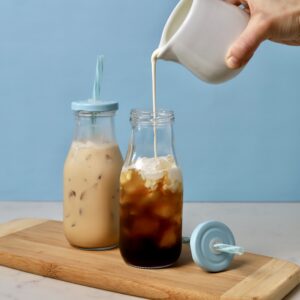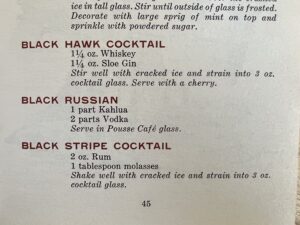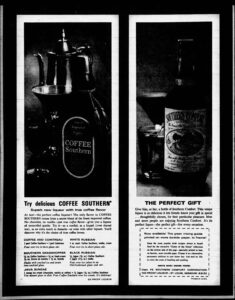
I was recently reminded of the White Russian when a lovely lady in one of my cocktail workshops asked if milk and Kahlua counted as a cocktail. Yes, Doreen, it counts. And it’s practically a White Russian!
In the 90’s, the White Russian was viewed as a bit tacky and old-fashioned, and it certainly wasn’t a popular drink. Until, of course, The Big Lebowski came out in 1998. The movie single-handedly resurrected the White Russian (or “Caucasian,” as it was called in the movie), propelling it back into modern consciousness. I can’t think of another character so inextricably linked with a cocktail as The Dude with the White Russian – maybe James Bond and the Vesper or Carrie Bradshaw and the Cosmopolitan. I thought Wayne Curtis put it rather eloquently in an Imbibe article on the subject when he argued that no other drink could have replaced the White Russian in The Big Lebowski. He writes: “The White Russian is simple to make, simple to drink, and appeals to those who are guileless of mind and buoyant of spirit, like The Dude himself. It is a liquid poem for those who fail to differentiate between day and night.”
Fittingly, there doesn’t seem to be an “official” White Russian recipe. Some people shake it, some people stir, and some just build it in the glass. Liquor.com calls for 2 oz. vodka, 1 oz. coffee liqueur, and just a splash of cream. Imbibe, on the other hand, recommends a 2:1:1 ratio, along with an unconventional half ounce of cooled coffee. The one I made – and loved – came from VinePair and used equal parts. I don’t find the vodka adds much to the drink flavor-wise, so I’ll happily reduce the ABV and have two drinks instead!
The moral of the story, I think, is to make your White Russian however you like. It isn’t a cocktail that needs to be taken too seriously.
History of the White Russian
In 1949, a Belgian bartender named Gustave Tops created a cocktail with coffee liqueur and vodka that he called the Black Russian – black for the coffee, Russian for the vodka. He mixed it up in honor of the U.S. diplomat to Luxembourg, Perle Mesta, who was presumably staying at the Hotel Metropole in Brussels where Tops worked. (There are a lot of examples of classic cocktails being created in hotel bars in honor of a distinguished visitor – I’m going to have to round them all up sometime.) A bit off topic, but Mesta sounds like quite a lady, more than deserving of her own signature cocktail. She was a wealthy widow from Oklahoma who became active in politics and the Washington, DC social scene. She would throw such glamorous parties that she inspired the phrase “hostess with the mostest.”
At some point in the 16 years that followed, an unknown bartender decided to make the inspired addition of cream to Tops’ original recipe, calling their new drink – what else? – a White Russian. There is some disagreement as to when the recipe first appeared in print. I saw several articles that said it first appeared in the 1961 edition of The Diners’ Club Drink Book, so I ordered a copy. And do you know what? It’s not in there. The Black Russian is there, but the White Russian is nowhere to be found. Liquor.com specifically says that it’s mentioned in a footnote for the Black Russian, but I don’t see one:

So I suspect the sources that say it first appeared in 1965 are correct. The recipe was printed in the Oakland Tribune on November 21, 1965, as part of an advertisement for Coffee Southern liqueur. I found the advertisement in question using Newspapers.com:

The drink hasn’t changed at all since 1965! And it’s equal parts vodka, coffee liqueur, and cream, just as I like it. This is one of my favorite things about classic cocktails – how they can connect us to the past in a very tangible way.
White Russian
1 1/4 oz. vodka
1 1/4 oz. coffee liqueur (Kahlua)
1 1/4 oz. heavy cream
Shake or stir with ice until chilled and strain into a rocks glass filled with ice. Or build it right in the glass!





